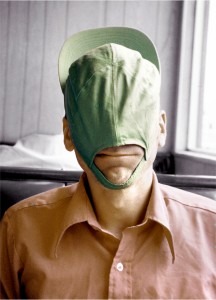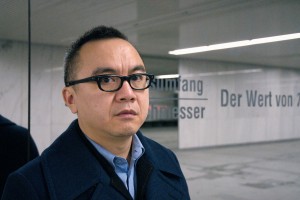
 Ken Lum
Ken Lum
born in 1956 in Vancouver, Canada; lives and works in Vancouver, Canada
Ken Lum is the descendent of the Chinese immigrants in Canada and a son of working-class parents, raised in East Vancouver. Being no stranger to the hard work and poverty of the working class, he often tells in his art the stories of the ordinary, hardworking people. His art is informed by empathy and sensitivity to their fate. Lum is also interested in the search of identity and invites the viewers to take part in this journey. He seeks to shake them, make them less certain and in that way broaden their horizons and allow them to gain a greater understanding of themselves. The Portrait-Repeated text series is among the most famous and critically acclaimed pieces by Lum. The posters present ordinary people captured when they are on their own. The text by the photo conveys their internal monologue, their emotions and thoughts. Through these works, the artist shows the aspects of life that are rarely depicted in art and allows us to hear the voice of people who usually don’t find their way into the public sphere. The works known as The Shopkeeper Signs explore the theme of the internal struggle “behind the scenes” and the clash between the public and the private image of self. The works expose the carefully constructed public image and show the suffering and real human emotions that are buried underneath it. Monument for East Vancouver is an illuminated installation that presents the image circulating for some time in the East Vancouver – the poorer, working-class district of the city, and also the place where Lum spent his childhood.
What do contemporary people need art for?
Contemporary people have no time for anything except going about what they are doing without challenging why the way things are. Contemporary people generally know nothing about contemporary art and many are resentful of artists. Which is why they need contemporary art, because contemporary art is about mindset. It may not make a person happier to have a wider field of vision. Indeed, it may have the opposite effect, but contemporary art does make the understanding of self and the experience of life deeper and more complete.
Why do you create art?
I create art because I believed it is the only area of true escape from the systematized and defined world, and although in recent years, I have developed great doubts about I still believe this.

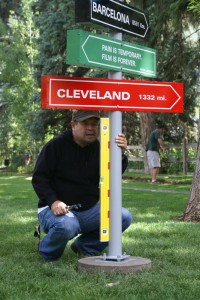 Marcos Ramirez ERRE
Marcos Ramirez ERRE
born 1961 in Tijuana, Baja California, Mexico; lives and works in Tijuana, Mexico and in San Diego, USA
ERRE does not have any formal training in art. A law graduate, he has always been interested in social and political issues. A political activist, he started using art forms to express ideas and point to important socio-political problems. Born in Mexico, yet having spent a large part of his life in the USA, he has both the insider’s knowledge of the problems of these two countries, as well as the outsider’s fresh perspective on them. This perspective is present in his works. A significant number of his artworks bring to the public attention the issue of Mexican-American borderland – the economic periphery, torn by conflicts and violence. One of his most important works is Toy an horse, a monumental wooden sculpture of a two-headed horse, created on the basis of the Homer’s description of the Trojan Horse in the Iliad, which points directly to the problem of Mexican-American borderland. Presenting the Trojan Horse as a two-headed creature is to point out the complex relationship between the two countries, where it is not really clear who is invading whom. Another work, Stop signs¸ symbolises the borderland, a confined zone governed by violent rules – the land of limitations, hate and fear. Eye charts is a series of works presenting poignant quotes from people such as Buddha or Desmond Tutu in the form of Snellen eye charts, used by ophthalmologists for eye tests. Just as normal eye charts are used to test visual acuity, ERREs eye charts are used to test the awareness and sensitivity to the suffering and evil that surrounds us.
What do contemporary people need art for?
Contemporary society today needs Art for the same reason that it has needed it since the first human being appeared in this world, because Art is a need and a tool for communication, the supreme expression of the soul, and the best way to understand ourselves, our needs, our deeds our motivations. This world without Art would be a very lame desert.
Why do you create art?
Because I care and that is the best way for me to express myself.
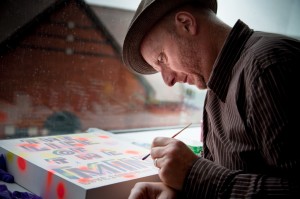
Photo by Chris Keenan
Bob and Roberta Smith
born in 1963 in London, UK; lives and works in London, UK
Bob and Roberta Smith makes art that carries social and political messages and seek to democratise the creation of art. Bob and Roberta Smith believes that art plays a powerful role in democratic systems, both as a forum for free speech and as a workshop to explore new futures. Smith has been focusing on issues surrounding mental health and feminism in his work. One of the most important exhibitions that Bob and Roberta Smith has been involved in is The Life of the Mind, held at The New Art Gallery Walsall from January to March 2011. Besides, Bob and Roberta Smith has exhibited extensively internationally and recent shows include, This is How we are Going to Change the World. I Should be in Charge, Hales Gallery, London, 2010, I Was Up All Night Making This, Cezare Manzo Gallery, Rome, 2009. Bob and Roberta Smith is an Honorary Fellow at the University of the Arts Bournemouth.
The piece is about the British coalition government and their closure of libraries all over the country Bob and Roberta Smith wonder what will happen to all of the books when libraries close. The image of book burning brings to mind connotations of Kristallnacht in 1938 and this destruction of creativity is both fascinating and terrifying to the artist.
What do contemporary people need art for?
Art is the principle means by which humanity defines itself. Human beings are cultural entities and everything in the world that has been made by humans has been considered visually. Everything is made.
Why do you create art?
I create art because I am absolutely no good at anything else.
 Daniele Buetti
Daniele Buetti
born in 1955 in Fribourg, Switzerland; lives and works in Zurich, Switzerland
For Buetti, art is a means of communication and a way of evoking emotions in people. The artist is above all interested in the influence of pop-cultural images and messages on our minds. He explores the ways in which mass media shape our identity, our ideas of beauty and our perception of reality. Working with pop-cultural images and exploring a wide range of techniques, Buetti is more interested in the concepts he wants to convey than in particular aesthetic medium. Fluegelkreuz (Winged Cross) and the happening Good Fellows Buetti explored the power of logo and the commercialisation of life. Apart from commenting on the way logo signs influence the value of goods, the projects shows how significantly different areas of life (including art, politics or social movements) are subjected to the laws of commerce in our times. In the Looking for Love and Dreams result in more dreams series, on the other hand, the artist explores the seductive power of mass media, the way in which they sell us the beautiful, glamorous (and fake) version of the reality.
Why do you create art?
Among other things, to find answer to the questions which bother me: In what ways does the ever growing domination of media in society influence consciousness? Which function and role do media play in the formation of identity? What ultimately constitutes identity, what does it represent? Will identity be eclipsed or completely replaced by “images” in a world which is characterised by electronic and print media? The beauties from the ads, brands and labels, stars, images and lifestyles are the symbols and concepts of the phenomenon that to me is more interesting from the social and cultural point of view, rather than from the aesthetic point of view. And from here comes the question: Why is the individual so rarely able to form his or her very own image of the world, to form his or her own, independent opinion, consequently craving outside help and patterns of orientation? A further question concerns the manner in which beauty icons today have become religious substitutes. Just like the figurines of saints offered on sale in churches, newspaper kiosks appear like displays of devotional objects where the portraits of modern saints promise salvation. “Why is a beautiful creature more deserving of compassion than an ugly one?” – this is one of the many questions that these icons ask in my works. So it’s the question about the importance of beauty in the moral, ethical discourse. Or, to put it differently, the fusion of absolute beauty and economic success at the beginning of the 21st century is the late-capitalist answer to the prediction of Dostojewski’s “idiot” that beauty would save the world.
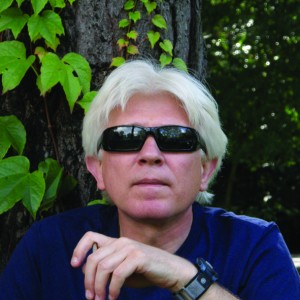
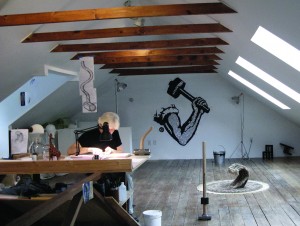 Adam Niklewicz
Adam Niklewicz
born in 1956 in Poland; lives and works in North Haven, Connecticut, USA
Adam Niklewicz earned his BFA in graphic communications from Washington University in St. Louis in 1989 and his MFA in sculpture from SUNY Purchase (State University of New York) in 2006. His work has been featured and discussed in ARTnews, the New York Times, Sculpture Magazine, Modern Painters Magazine and the Nation, among others, and shown at such venues as Real Art Ways, Galerie fur Landschaftskunst (Hamburg, Germany), the New Britain Museum of American Art, the Stamford Museum, Grounds for Sculpture, Black & White Gallery, FiveMyles, Slag Gallery and Zacheta (Warsaw, Poland). His 2011 engagements include exhibitions at Galeria Sztuki Wspolczesnej (the Gallery of Contemporary Art) in Opole, Poland and Black & White Gallery/Project Space in New York City.
Niklewicz’s work thrives on surprise and plays with de-contextualization. The objects of his attention are quite ordinary. These are tables, chairs, plates and a host of other items that have a role to play in the network of daily experiences that define the practical world. Niklewicz stands back and assumes a detached view of the objects attempting to discover new and secret aspects of reality by making obvious things odd and finding playful qualities along with clear and palpable symbolism. Such contemplative detachment translates into absurd situations suspended of practicality but with healthy dose of irony and humor – all communicated through mediums ranging from sculpture, video, installation and conceptual photography.
What do contemporary people need art for?
Art, like reality, is in constant flux. Ever changing, ever fresh.
Why do you create art?
A way of making sense of this world.
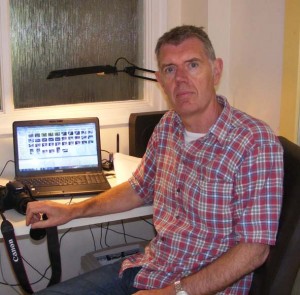
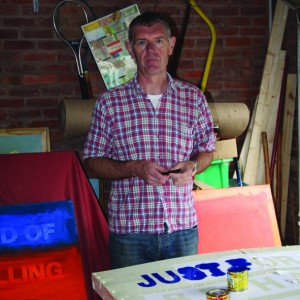 Andy D Willett
Andy D Willett
born in 1957 in Stoke on Trent, England; lives and works in Rugby, England
He worked as a self employed Sign maker and Designer for around 20 years before studying Fine Art as a mature student. He is interested using the devices, technology and information delivery systems of mass communication to hopefully initiate a re-examination of our acquired viewing responses.
As a society and as individuals we are taught to respond in certain ways to visual stimuli both in terms of content and materials, and in his work he’s asking the viewer to reassess the way they respond to the materials and the form as much as the message. By using the power of materials, familiarity and humour he’s attempting to lead the viewer into an elaborate series of associations, which at the heart look at fundamental human relations, desires and failings.
What do contemporary people need art for?
There are as many different views about Art today as there are Artists.
Why do you create art?
I’ve been making Art for so long I have forgotten why I started.
I am reminded of the quotation by Albert Camus: “The more I produce, the less I am certain. On the road along which the artist walks, night falls ever more densely. Finally, he dies blind”.
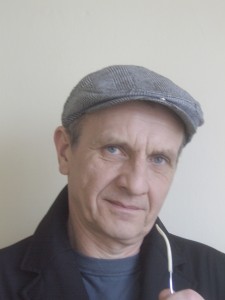
 Jerzy Kosałka
Jerzy Kosałka
born in 1955 in Będzin, Poland; lives and works in Wrocław, Poland
After graduating from the Academy of Fine Art in Wrocław in 1981, where he specialised in painting, Kosałka immediately rejected this means of expression, which he considered not a particularly convincing medium and turned to interdisciplinary work instead. He started to build installations, create objects or use readymades employing different technologies and means of expression. He makes films and organises performances, he also creates art in the public sphere, which he considers a very important place for contemporary art. In terms of inspiration, he calls himself a realist-artist, since the surrounding reality is the main subject of his art. He interprets and processes this reality and in doing so, he often uses irony, which is his favourite artistic strategy. Lately, he has been particularly interested in the “site-specific” method, since he enjoys working on projects in which the local context of the presentation site is taken into consideration. One of the most interesting projects of this kind was the “Bioart and other works” exhibition in the Bomba art club in Kraków. The most spectacular of his latest projects was creating the “CosalCa-Club” in the Zero gallery in Berlin. At the opening of the club, female art curators, who had been previously recruited through a special competition, were pole dancing, while Kosałka presented a few performances, such as “Conjuring up a goldfish” or “The miracle of turning Coca-Cola into wine”, in which he used the classic technique taken from the magician’s acts. This technique is his favourite strategy to be employed in performances. Among the awards he has received, the one he finds most valuable is the Krystiana Robb-Narbut Foundation award, which was conferred upon him in 2010 in recognition of his independent artistic activity. Lately, after 30 years, he has returned to painting and his works prepared for the 2009 “Bielska Jesień” Biennale received four special awards from professional art journals.
What do contemporary people need art for?
Well, do they? I think that contemporary art constitutes a niche in visual arts, which are in turn a niche in art in general, which is itself a niche in culture, while the need of culture is a niche in the general needs of the society. How can you claim otherwise if society doesn’t spend even 1 per cent of its budget on culture?
Why do you create art?
Because it’s a space for Absolute Freedom for me.
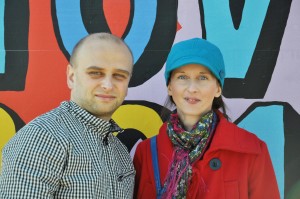
 Galeria Rusz (Joanna Górska and Rafał Góralski)
Galeria Rusz (Joanna Górska and Rafał Góralski)
both born in 1973, live and work in Toruń, Poland
Galeria Rusz is an art group based in Toruń, established by the two artists: Joanna Górska and Rafal Góralski. Their main interest is the creation and presentation of art in public space. Since 1999, they’ve run their own billboard gallery at Szosa Chełmińska 37 in Toruń, called ‘Galeria Rusz’, which is the world’s longest ever existing project displaying art on the same billboard and in the same location. Górska and Góralski create billboard posters, paintings, murals, undertake artistic interventions and public art actions. The artists have so far created over 200 artistic billboards. Their work is concerned both with the private, individual sphere of life (which might be, in a simplified manner, called a psychological sphere) and with the external, collective sphere (which might be, in a simplified manner, called a social sphere). This division is rather symbolic and blurry – it is to underline the fact that through their work they try to describe the complex situation of the human being, who is both an individual and a member of a larger community, with all the dependencies stemming from this fact. Their works provide a new frame for certain fragments of reality, a frame allowing for new interpretations. They encourage the viewer to frame their perception of certain phenomena in a new way, to play with the frames providing context for the interpretation of a given phenomenon.
Artists from Galeria Rusz have received numerous awards, they have also been granted artistic scholarships, such as the prestigious “Młoda Polska” Ministry of Culture and National Heritage Scholarship in 2009. In 2007, they were nominated for the “Spojrzenia 2007” Deutsche Bank Foundation Award. They have participated in various exhibitions in Poland and abroad, including “Take a look at me now” exhibitions at the Sainsbury Centre for Visual Arts in Norwich as a part of Polska! Year in Great Britain in 2009.
What do contemporary people need art for?
Art can provide a deeper understanding of ourselves and of other people. It can be a journey into a deeper level of reality. Contemporary people badly need such a journey in order to communicate with their own selves and with the external world.
Why do you create art?
Because we want to MOVE ourselves and other people.

